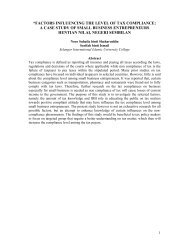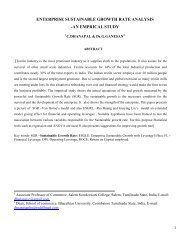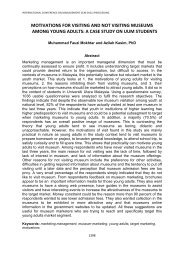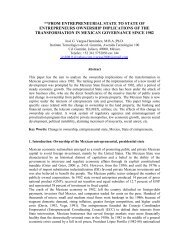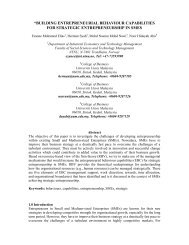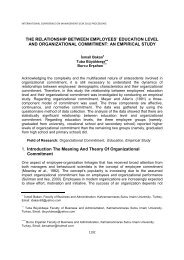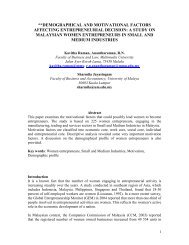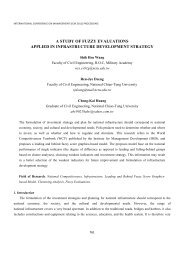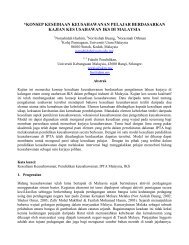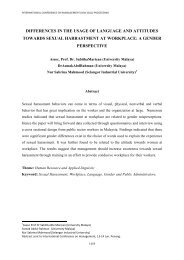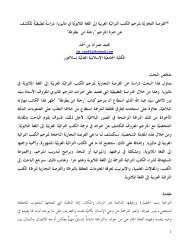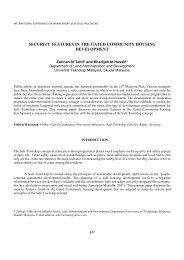operational analysis of a select spinning mill - International ...
operational analysis of a select spinning mill - International ...
operational analysis of a select spinning mill - International ...
You also want an ePaper? Increase the reach of your titles
YUMPU automatically turns print PDFs into web optimized ePapers that Google loves.
4 Gokhale, G S (1992) an important factor that affects material productivity is the quality<br />
<strong>of</strong> cotton that is used to produce a particular kind <strong>of</strong> yarn or cloth. Using too good a cotton<br />
variety would contribute to excessive cost, but using cotton that is not good enough would mean<br />
increased breakage, a heavier work load for the worker, who consequently can only attend to a<br />
lesser number <strong>of</strong> machine units. The material productivity is influenced by a number <strong>of</strong> factors<br />
such as quality <strong>of</strong> material used, type <strong>of</strong> technology used, level <strong>of</strong> maintenance and life <strong>of</strong><br />
machinery, count produced and the like.<br />
5 Productivity also depends upon such factors as layout <strong>of</strong> machines, mechanical transport<br />
for material handling and machine maintenance. As a result <strong>of</strong> all these factors, productivity <strong>of</strong><br />
the worker is largely governed by a proper machine allocation. This can easily be determined by<br />
work-study.<br />
6 SITRA (1998) stated that the size <strong>of</strong> the <strong>mill</strong>s decides the volume <strong>of</strong> business and also the<br />
economic viability <strong>of</strong> the business unit. Selection <strong>of</strong> suitable size is important for smooth conduct<br />
<strong>of</strong> business, over-capacity as well as under- capacity would bring pressure on the business.<br />
5. SIGNIFICANCE OF THE STUDY<br />
The new textile policy is to be seen in the backdrop <strong>of</strong> fast changing international<br />
scenario in the post-.GATT era and its implications on Indian textile sector. Textile and clothing<br />
have been brought within the framework <strong>of</strong> GATT in the Uruguay round <strong>of</strong> the multilateral trade<br />
negotiations. The first impact <strong>of</strong> this negotiation would be felt by the Indian textile industry after<br />
the expiry <strong>of</strong> Multi Fiber Agreement (MFA) on December 31, 2004. Expiry <strong>of</strong> MFA would have<br />
implications on both inter-national as well as domestic markets. The Indian textile industry has to<br />
be globally competitive to be able to sustain its presence not only in the international market but<br />
also in the domestic.<br />
On the other side technological capability is embodied in the human and physical capital<br />
in command <strong>of</strong> the industry. In a dynamic sense it means the ability <strong>of</strong> the industry to articulate<br />
its business problems in terms <strong>of</strong> technology and also the ability to access human, physical,<br />
financial and organizational resources to find solutions to the articulated technological problems.<br />
_______________________________________________<br />
4 Gokhale, G S (1992) 'The Role <strong>of</strong> Productivity in Cotton Mill Sector', Journal <strong>of</strong> Productivity, January-<br />
March.<br />
5 Porter, Michael (1992): Quoted in G S Gokhale, 'Role <strong>of</strong> Productivity in Cotton Textile Mill Industry',<br />
Productivity, Vol 33, No 1 April- June.<br />
6 SITRA (1998): 'Productivity Performance in Spinning', SITRA Publication, South Indian Cotton Textile<br />
Research Association, Coimbatore, p 4.<br />
4




